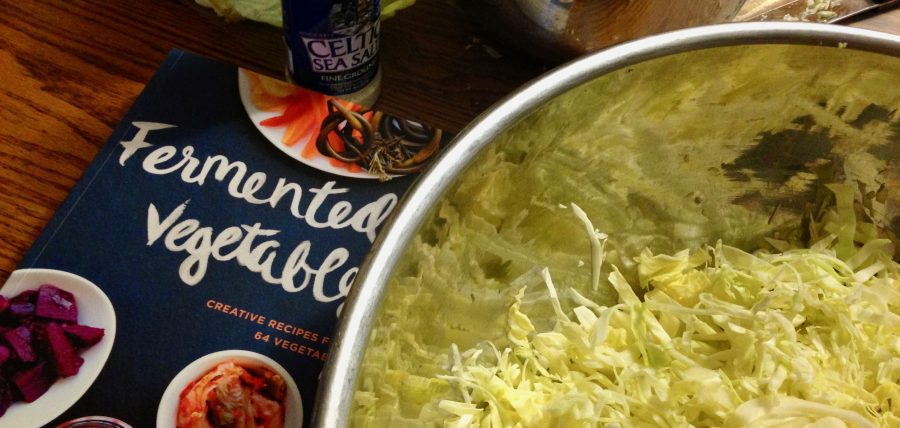Forget about eating for yourself. Did you know that your body is home to trillions of beneficial bacteria, and the standard American diet is starving them out? These good bugs are part of your microbiome, a newly coined phrase that refers to your body’s ecosystem – both the human part of you and the microbial part of you. Did you know that microbial cells outnumber human cells in your body 10 to 1?
Before you go reaching for the antiseptic spray, know that the majority of these bugs are good for you. Very good for you. In fact, hundreds of scientists throughout the world are currently studying the human microbiome, and their recently published research is changing the way we think about health and the human body. They even have their own Disney-esque Microbiome Movie, thanks to the folks at NPR.
The Capitol City of your microbiome is your gut, home to approximately 100 trillion critters that can affect your health in a surprising variety of ways. Not only do they work in tandem with your body and aid digestive function, but they also enhance immune strength and protect you from less desirable critters by making your body less hospitable to unruly house guests like E. coli and Candida.
Your Microbiome May Affect…
- Your Weight
- Your Mood
- Gut Health (including digestion and elimination, Celiac disease, food issues, leaky gut, etc)
- Cancer Risk
- Obesity & Blood Sugar Metabolism
- Immune Strength
- Autoimmune Disease & Allergies
- Yeast & Urinary Tract Infections
- And More!
Cultivating a Healthy Microbiome
Start Life Off Right: Your first exposure to beneficial bacteria begins as you enter the world through the birth canal. This and breastfeeding supply you with good bacteria from your mum. In contrast, babies born by C-section and who are bottle fed start life off at a microbial disadvantage. Alas, unless you’re about to have a baby and aim to gift your little one with a solid microbial start, this information is too late to act upon. Nonetheless, these are two of the primary ways that we begin to cultivate a healthy microbiome. If you weren’t lucky enough to get this natural dose of the goods, there are still things you can do…
Avoid Antibiotics: Antibiotics may be necessary to fend off serious bacterial diseases. However, in doing so, they kill off the good guys as well. Only use antibiotics when they’re truly necessary for medicine, and take protibiocs during and after antibiotic treatment to help offset the damage (more on that in a moment). Also consider seeking out food from animals raised naturally without antibiotics automatically added to their feed. This practice is prohibited for organically certified meat and dairy products, and many local and pasture- or grass-based farmers also eschew the practice.
Add in Probiotics: There are two main ways to do this…
- Fermented Food helps recolonize the good guys. Although fermented dairy is popular (think: yogurt and kefir with live active cultures), also consider other forms of fermented foods including lactofermented veggies like real sauerkraut and kimchi. I love Micro Mama’s products (made with organic local vegetables and available in the produce section of the Co-op), and I also make my own – it’s really easy (details, directions and pics here)!
- Probiotic Supplements offer a big dose of good guys when needed, and they are mighty convenient. Opt for a probiotic with Lactobacillus and Bifidobacterium, at least 1 billion daily, though you may want to take much larger amounts than that. Seek out products with a special coating to help the live bacteria travel safely through the stomach (filled with germ-killing acid) and release in the intestines where they are most useful.
Feed them Prebiotics: Probiotics need something to chew on in order to thrive. In particular, they love fiber and resistant starch, especially certain foods and herbs. Prebiotics specifically encourage the growth of good guys. But, if your diet is devoid of these good foods, you may want to add them in sloooowly while also boosting your good guys with probotics and/or fermented foods. Expect a transition time of gas and bloating (especially if you jump right in). This is like getting sore after your first workout in years – your body needs to get used to what’s happening and become recolonized with the good guys. Our ancestors (who had amazing microbiomes) used to get more than 100 grams of fiber a day. Most Americans get an abysmal 15 grams. Here are some examples…
- Inulin, a type of fiber sold as and naturally present in sunflower family root vegetables including chicory, dandelion, burdock, and Jerusalem artichokes (aka sunchokes) as well as above ground parts (artichokes, dandelion leaves) and other plants like garlic, onions, leeks, broccoli, and asparagus. The less cooked, the better. This is like gourmet food for your good critters.
- Fiber-Rich Whole Foods also support the good guys, especially beans, whole grains (in moderation), leafy greens, nuts, seeds, and plenty of veggies. Resistant starch is sometimes considered a third type of fiber (beyond soluble and insoluble); these carbohydrates are not digested by the human side of our digestive system. Beans, green bananas, and unprocessed whole grains contain resistant starch. Heating, then cooling, starchy foods (think: potatoes, rice, beans) will also turn some of those carbohydrates into resistant starch.
- Herbs & Spices, while their effects on the microbiome have not yet been as well researched as inulin and fiber, they do seem to provide benefit. Specifically, ginger and rose petals have been shown to inhibit pathogenic germs while encouraging the vitality of beneficial probiotic.
Get Out in Nature: “As the amount of glass and concrete in your neighborhood increases and the diversity of native plants decreases, the microbial composition of your skin changes and the risk for allergies goes up,” notes Leach in Honor Thy Symbionts. Spending time outside, near and in dirt and trees, and with windows wide open helps counteract the negative effects of city living.
Get Dirty: On the same line as “get out in nature,” don’t be afraid of a little exposure to dirt and germs through gardening, organic produce with clods of dirt still attached, hanging out with pets and other animals, and using plain soap and water to wash up rather than disinfectants and sanitizer.
Heal the Gut: Once again, this is the herbalist in me talking. Microbiome research hasn’t really delved into it just yet. However, many people who are in a state of dysbiosis (too many bad guys, too few good guys) experience digestive discomfort ranging from irritable bowel syndrome (IBS) to serious inflammatory bowel disease (IBD) and including gas, pain, bloating, diarrhea and/or constipation, indigestion, increased food allergies and autoimmune disease, and gut inflammation including leaky gut (aka intestinal permeability). Herbs that heal wounds (plantain leaf, calendula flowers, etc.), tighten and tone the gut lining (rose petals, plantain leaf) soothe and slime mucous membranes (slippery elm, marshmallow root, licorice), and support good microbes while discouraging the bad (ginger, rose petals, cinnamon, licorice, spices) can all play a role in rehabilitating your gut and microbiome. My favorite way to deliver these herbs is via tea, which is easy to make and quite tasty.
Though this research is still new, the principles behind a microbiome-friendly diet are ancient and certainly worth trying. Now, put down the hand sanitizer, and find yourself a bowl of beans, dandelion greens, and kraut…
Most of the information is gleaned from the work of Jeff Leach. Check out his books and also learn more at humanfoodproject.com and hmpdacc.org. This post was originally written for the Concord Food Co-op and has been re-used with permission.
Maria sees clients and teaches classes at Wintergreen Botanicals Herbal Clinic & Education Center in Allenstown.
The statements made on this blog have not been evaluated by the FDA and are not intended to diagnose, prescribe, recommend, or offer medical advice. Please see your health care practitioner for help regarding choices and to avoid herb-drug interactions.

